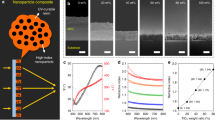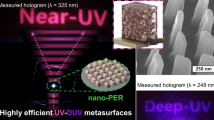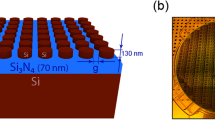Abstract
Metalenses are attractive alternatives to conventional bulky refractive lenses owing to their superior light-modulating performance and sub-micrometre-scale thicknesses; however, limitations in existing fabrication techniques, including high cost, low throughput and small patterning area, have hindered their mass production. Here we demonstrate low-cost and high-throughput mass production of large-aperture visible metalenses using deep-ultraviolet argon fluoride immersion lithography and wafer-scale nanoimprint lithography. Once a 12″ master stamp is imprinted, hundreds of centimetre-scale metalenses can be fabricated using a thinly coated high-index film to enhance light confinement, resulting in a substantial increase in conversion efficiency. As a proof of concept, an ultrathin virtual reality device created with the printed metalens demonstrates its potential towards the scalable manufacturing of metaphotonic devices.
This is a preview of subscription content, access via your institution
Access options
Access Nature and 54 other Nature Portfolio journals
Get Nature+, our best-value online-access subscription
$29.99 / 30 days
cancel any time
Subscribe to this journal
Receive 12 print issues and online access
$259.00 per year
only $21.58 per issue
Buy this article
- Purchase on Springer Link
- Instant access to full article PDF
Prices may be subject to local taxes which are calculated during checkout





Similar content being viewed by others
Data availability
The data supporting the findings of this study are available from the corresponding authors upon reasonable request.
References
Chen, X. et al. Dual-polarity plasmonic metalens for visible light. Nat. Commun. 3, 1198 (2012).
Khorasaninejad, M. et al. Metalenses at visible wavelengths: diffraction-limited focusing and subwavelength resolution imaging. Science 352, 1190–1194 (2016).
Chen, K. et al. A reconfigurable active Huygens’ metalens. Adv. Mater. 29, 1606422 (2017).
Schlickriede, C. et al. Imaging through nonlinear metalens using second harmonic generation. Adv. Mater. 30, 1703843 (2018).
Yoon, G., Kim, K., Huh, D., Lee, H. & Rho, J. Single-step manufacturing of hierarchical dielectric metalens in the visible. Nat. Commun. 11, 2268 (2020).
Zhou, Y., Zheng, H., Kravchenko, I. I. & Valentine, J. Flat optics for image differentiation. Nat. Photon. 14, 316–323 (2020).
She, A., Zhang, S., Shian, S., Clarke, D. R. & Capasso, F. Adaptive metalenses with simultaneous electrical control of focal length, astigmatism, and shift. Sci. Adv. 4, eaap9957 (2018).
Wang, S. et al. A broadband achromatic metalens in the visible. Nat. Nanotechnol. 13, 227–232 (2018).
Chen, W. T. et al. A broadband achromatic metalens for focusing and imaging in the visible. Nat. Nanotechnol. 13, 220–226 (2018).
Lin, R. J. et al. Achromatic metalens array for full-colour light-field imaging. Nat. Nanotechnol. 14, 227–231 (2019).
Lee, G.-Y. et al. Metasurface eyepiece for augmented reality. Nat. Commun. 9, 4562 (2018).
Li, Z. et al. Meta-optics achieves RGB-achromatic focusing for virtual reality. Sci. Adv. 7, eabe4458 (2021).
Li, Z. et al. Inverse design enables large-scale high-performance meta-optics reshaping virtual reality. Nat. Commun. 13, 2409 (2022).
Engelberg, J. & Levy, U. The advantages of metalenses over diffractive lenses. Nat. Commun. 11, 1991 (2020).
She, A., Zhang, S., Shian, S., Clarke, D. R. & Capasso, F. Large area metalenses: design, characterization, and mass manufacturing. Opt. Express 26, 1573–1585 (2018).
Tao, J. et al. Mass-manufactured beam-steering metasurfaces for high-speed full-duplex optical wireless broadcasting communications. Adv. Mater. 34, 2106080 (2022).
Leitis, A., Tseng, M. L., John-Herpin, A., Kivshar, Y. S. & Altug, H. Wafer-scale functional metasurfaces for mid-infrared photonics and biosensing. Adv. Mater. 33, 2102232 (2021).
Park, J.-S. et al. All-glass, large metalens at visible wavelength using deep-ultraviolet projection lithography. Nano Lett. 19, 8673–8682 (2019).
Zheng, G. et al. Metasurface holograms reaching 80% efficiency. Nat. Nanotechnol. 10, 308–312 (2015).
Lin, D., Fan, P., Hasman, E. & Brongersma, M. L. Dielectric gradient metasurface optical elements. Science 345, 298–302 (2014).
Schmid, H. & Michel, B. Siloxane polymers for high-resolution, high-accuracy soft lithography. Macromolecules 33, 3042–3049 (2000).
Shen, F. & Wang, A. Fast-Fourier-transform based numerical integration method for the Rayleigh-Sommerfeld diffraction formula. Appl. Opt. 45, 1102–1110 (2006).
Engelberg, J. & Levy, U. Standardizing flat lens characterization. Nat. Photon. 16, 171–173 (2022).
Engelberg, J. & Levy, U. Generalized metric for broadband flat lens performance comparison. Nanophotonics 11, 3559–3574 (2022).
Yang, Y. et al. Revealing structural disorder in hydrogenated amorphous silicon for a low-loss photonic platform at visible frequencies. Adv. Mater. 33, 2005893 (2021).
Goodman, J. W. Introduction to Fourier Optics (McGraw-Hill, 1996).
Song, J.-H., van de Groep, J., Kim, S. J. & Brongersma, M. L. Non-local metasurfaces for spectrally decoupled wavefront manipulation and eye tracking. Nat. Nanotechnol. 16, 1224–1230 (2021).
Faisal, A. Computer science: visionary of virtual reality. Nature 551, 298–299 (2017).
Ni, J. et al. Multidimensional phase singularities in nanophotonics. Science 374, eabj0039 (2021).
Koshelev, K., Lepeshov, S., Liu, M., Bogdanov, A. & Kivshar, Y. Asymmetric metasurfaces with high-Q resonances governed by bound states in the continuum. Phys. Rev. Lett. 121, 193903 (2018).
Tittl, A. et al. Imaging-based molecular barcoding with pixelated dielectric metasurfaces. Science 360, 1105–1109 (2018).
Yesilkoy, F. et al. Ultrasensitive hyperspectral imaging and biodetection enabled by dielectric metasurfaces. Nat. Photon. 13, 390–396 (2019).
Ruan, Q. et al. Reconfiguring colors of single relief structures by directional stretching. Adv. Mater. 34, 2108128 (2022).
Liu, H. et al. Tunable resonator-upconverted emission (TRUE) color printing and applications in optical security. Adv. Mater. 31, 1807900 (2019).
Badloe, T. et al. Liquid crystal-powered Mie resonators for electrically tunable photorealistic color gradients and dark blacks. Light Sci. Appl. 11, 118 (2022).
Jang, J. et al. Spectral modulation through the hybridization of Mie-scatterers and quasi-guided mode resonances: realizing full and gradients of structural color. ACS Nano 14, 15317–15326 (2020).
Fang, X., Ren, H. & Gu, M. Orbital angular momentum holography for high-security encryption. Nat. Photon. 14, 102–108 (2020).
Kim, J. et al. Photonic encryption platform via dual-band vectorial metaholograms in the ultraviolet and visible. ACS Nano 16, 3546–3553 (2022).
Bao, Y., Wen, L., Chen, Q., Qiu, C.-W. & Li, B. Toward the capacity limit of 2D planar Jones matrix with a single-layer metasurface. Sci. Adv. 7, eabh0365 (2021).
Kim, J. et al. Metasurface holography reaching the highest efficiency limit in the visible via one-step nanoparticle-embedded-resin printing. Laser Photonics Rev. 16, 2200098 (2022).
Song, Q., Odeh, M., Zúñiga-Pérez, J., Kanté, B. & Genevet, P. Plasmonic topological metasurface by encircling an exceptional point. Science 373, 1133–1137 (2021).
Acknowledgements
This work was financially supported by the POSCO-POSTECH-RIST Convergence Research Center programme funded by POSCO, the Samsung Research Funding & Incubation Center for Future Technology grant (SRFC-IT1901-52) funded by Samsung Electronics, and the National Research Foundation (NRF) grants (NRF-2022M3C1A3081312, NRF-2022M3H4A1A02074314, NRF-2022M3H4A1A02085335, NRF-2021M3H4A1A04086554, NRF-2021K2A9A2A15000174, NRF-2019R1A2C3003129, NRF-2019R1A5A8080290, CAMM-2019M3A6B3030637) funded by the Ministry of Science and ICT (MSIT) of the Korean government. H.L. acknowledges the NRF grant (NRF-2019K1A4A7A02113032) funded by the MSIT, and Technology Innovation Program (20016234) funded by the Ministry of Trade, Industry & Energy of the Korean government. J.K. and H.K. acknowledge the POSTECH Alchemist fellowships. D.K.O., Y.Y. and Y.K. acknowledge the Hyundai Motor Chung Mong-Koo fellowships. Y.Y. and Y.K. acknowledge the NRF PhD fellowships (NRF-2021R1A6A3A13038935 and NRF-2022R1A6A3A13066251, respectively) funded by the Ministry of Education of the Korean government. Y.K. acknowledges the NRF International Research & Development fellowship (NRF-2022K1A3A1A12080445) funded by the MSIT of the Korean government. The authors thank T. Badloe (POSTECH) for English proofreading and fruitful discussion.
Author information
Authors and Affiliations
Contributions
J.R. and H.L. conceived the idea and initiated the project. J.R. and J.K. designed the whole experiments. J.K., S.K., H.K., S.-W.M., J.P., Y.K., J.R. and N.P. performed the theoretical and numerical simulations. W.K., J.K., J.S., D.K.O., Y.Y., C.P., H.C., G.J., K.L. and D.H.Y. contributed to the master mould fabrication and nanoimprinting. J.S., J.K., J.J. and M.J. performed the experimental characterization and data analysis of the materials and devices. G.-Y.L. and B.L. supported the experimental part of VR display. J.K., J.S. and J.R. mainly wrote the manuscript. All the authors confirmed the final manuscript. J.R. guided the entire project.
Corresponding authors
Ethics declarations
Competing interests
The authors declare no competing interests.
Peer review
Peer review information
Nature Materials thanks Jay Guo, Yuri Kivshar and the other, anonymous, reviewer(s) for their contribution to the peer review of this work.
Additional information
Publisher’s note Springer Nature remains neutral with regard to jurisdictional claims in published maps and institutional affiliations.
Supplementary information
Supplementary Information
Supplementary Notes 1–20.
Rights and permissions
Springer Nature or its licensor (e.g. a society or other partner) holds exclusive rights to this article under a publishing agreement with the author(s) or other rightsholder(s); author self-archiving of the accepted manuscript version of this article is solely governed by the terms of such publishing agreement and applicable law.
About this article
Cite this article
Kim, J., Seong, J., Kim, W. et al. Scalable manufacturing of high-index atomic layer–polymer hybrid metasurfaces for metaphotonics in the visible. Nat. Mater. 22, 474–481 (2023). https://doi.org/10.1038/s41563-023-01485-5
Received:
Accepted:
Published:
Issue Date:
DOI: https://doi.org/10.1038/s41563-023-01485-5
This article is cited by
-
Integral imaging near-eye 3D display using a nanoimprint metalens array
eLight (2024)
-
Multichannel meta-imagers for accelerating machine vision
Nature Nanotechnology (2024)
-
Dual-wavelength metalens enables Epi-fluorescence detection from single molecules
Nature Communications (2024)
-
Wide field-of-hearing metalens for aberration-free sound capture
Nature Communications (2024)
-
A water-soluble label for food products prevents packaging waste and counterfeiting
Nature Food (2024)



